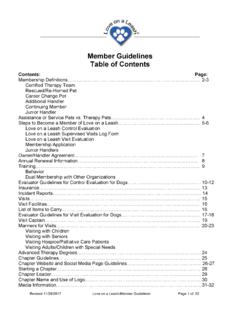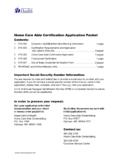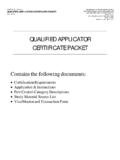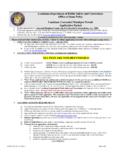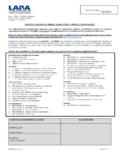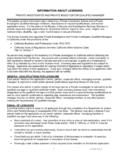Transcription of Application for Dogs-2
1 Revised 1/30/2018 Love on a Leash- Application packet for Dogs Page 1 of 13 Application Checklist for Dog Therapy Team NOTE: Every person who will be a handler for a dog must submit a completed Control Evaluation, Supervised Visits Log, Visit Evaluation, and Membership Application . All forms, photos, and checks must be sent together, in the same packet (except for email headshot of dog.) Please keep copies of all of your forms, applications , etc. for your records and in case of lost or damaged Application packets. Incomplete applications and/or incorrect fees are the most common reasons for membership applications to be delayed or returned. applications may take 6-8 weeks for processing.
2 Please read and double-check the instructions on each form! Questions? Call Love on a Leash at (760) 740-2326 or email at Checklist: Completed LOAL Control Evaluation The Control Evaluation and the Visit Evaluation must be done by two different evaluators. Completed Supervised Visits Log Only one hour per day is allowed to be counted for the minimum ten hours. Completed Visit Evaluation The Control Evaluation and the Visit Evaluation must be done by two different evaluators. Complete Membership Application packet (all 12 pages of the Application are required). All documents must be completed and submitted within one year from date of Control Evaluation.
3 A Junior Handler Application must include Junior Handler Release Agreement. Include with your Application , two (2) full-body photographs of the dog (for LOAL to keep on file). Email a headshot of your dog s face for his or her ID card to Please send photo in portrait orientation. In your email, include your name, your pet s name, phone number, and address. Send the above with a check for the appropriate fees and membership dues (applicant will be responsible for any service charges or fees incurred from a returned check) to: Love on a Leash PO Box 4548 Oceanside, CA 92052-4548 Thank you! Revised 1/30/2018 Love on a Leash- Application packet for Dogs Page 2 of 13 Evaluator Guidelines for CONTROL Evaluation for Dogs This evaluation for dogs must be administered by a Certified Behaviorist, Certified Dog Trainer, Certified Obedience Instructor, or AKC approved Canine Good Citizen Evaluator, and is to be fully and successfully completed before going on any supervised visits.
4 The Control Evaluation and the Visit Evaluation must be administered by two different evaluators. Candidates for membership cannot evaluate their own pets. Your pet must be a minimum of one year old before beginning the certification process. If a rescue, re-homed or career change pet, it is strongly recommended you take a minimum of 6 months to bond with this pet and get to know its reactions in various situations. The LOAL Control Evaluation is to test the temperament of the dog and the amount of control that the handler has in various situations. These guidelines are meant to give the evaluator objective criteria and to make the test as consistent as possible in all parts of the country.
5 All parts of the evaluation should be performed with the dog on a four foot leash. If the dog shows aggression towards any person or dog, the evaluation should be stopped and the dog disqualified. The handler may talk to the dog and encourage him, but no treats may be used during the evaluation. Additionally, no prong, pinch or electronic collars, of any kind, may be used 1. I have read and will abide by the LOAL Evaluator Guidelines, accompanying this form, when evaluating this team. As an evaluator you have a responsibility of deciding whether or not this team is ready to begin their supervised visits. By signing off on a team you are acknowledging that the team has satisfactorily performed all required tasks on the Love on a Leash Control Evaluation.
6 Be sure to include your CGC Evaluator # (if applicable) and include a business card in case you need to be contacted by National Love on a Leash. 2. Is the dog able to do a sit, lie down, heel with people close by, and come when called while on a leash? The dog must sit and lie down at the handler s command. The handler may repeat the command, but no more than two times. It must be obvious that the dog is responding to the handler s command. A hand signal may be used, but no force, such as pulling down on the leash or pushing the dog into position. The dog should stay in position for at least three seconds before being released. The dog should be able to heel by the owner s side while walking through a crowd.
7 The dog must be under complete control without pulling on the leash. If the dog is pulling the handler or paying too much attention to other people, the dog should not pass. The criteria should not, however, be one of competitive obedience. When called to come, the dog should go directly to the handler and not run past. This is not a test of stay . If necessary, the evaluator may gently hold the dog in position until called - the dog does not need to remain in a sit position. The handler may coax the dog with his voice, but may not use the leash to bring him in. Revised 1/30/2018 Love on a Leash- Application packet for Dogs Page 3 of 13 3. Is the dog able to do a two minute down or sit/stay with the owner holding the leash?
8 The two minute stay may be done in either the sit or down position. It is the handler s choice. Whatever position the handler chooses, the dog should stay in that position the entire two minutes. The handler may stay close but must not hold the dog in position. He may encourage the dog with his voice. If the dog is sitting, he should not lie down and, if lying down, he should not sit up. The dog may move around in position, but not crawl or leave his spot. If the dog gets up or moves away, the evaluator should start the time again, but no more than two times. 4. Is the handler able to greet a friendly stranger who has a dog? Is the handler able to maintain control without the dog being aggressive or over stimulated?
9 The handler and dog should approach another dog and handler from a distance of about 20 feet, stop, shake hands, exchange brief pleasantries and then move on. (The neutral dog should be proofed prior to the test to make sure that he will remain calm). If, for some reason, the neutral dog reacts to the dog being tested, the test may be redone with another dog. This will demonstrate that the dog can behave while the owner greets another person, who is also with a dog. The dog being tested may show casual interest, but must stay by the handler s side. The dog does not need to sit, but should not cross in front of or behind the handler. The handler may talk to their dog to encourage it.
10 5. Does the dog allow petting including having its head, ears, feet and tail touched? The dog may sit, lie down, or stand. The owner should hold the dog. The evaluator should approach the dog in a calm, friendly manner, kneel in front or to the side of the dog and touch the dog s head, ears, run his hands down the dog s side, touch and very lightly squeeze the dog s paws and tail. The dog should not shown signs of fear, aggression or shyness. He may move toward the tester, but must not lunge or jump. He may roll over onto his back, but should not wiggle too much. He must be under the control of the handler at all times. He may stand or lie down to receive attention.

